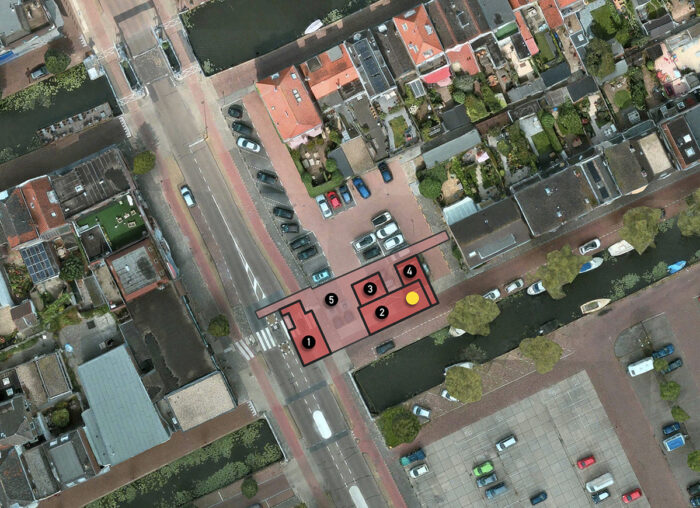
1955. Gesloten en dicht getimmerd.
1955. Closed and boarded up

1960. De synagoge wordt gesloopt.
1960. The synagogue is being demolished.

Tegenwoordige situatie.
Present situation.
In de meeste dorpen rondom Maassluis en in steden als Schiedam en Delft waren Joden tot 1786 niet welkom. Maassluis was wel gastvrij. Het was een van de weinige gemeenten in Zuid-Holland waar zich voor 1700 al Joden mochten vestigen.
In de jaren na 1700 neemt het aantal Joden in Maassluis langzaam toe. In 1769 geeft de Gemeenteraad van Maassluis toestemming voor de oprichting van een Joodse gemeenschap met een eigen synagoge. Deze eerste synagoge komt aan de Korte Boonestraat, hier een paar straten vandaan, en is in 1769 ingewijd.
Rond 1800 heeft Maassluis een behoorlijke Joodse gemeenschap van tegen de honderd mensen die tientallen jaren min of meer constant blijft. In 1831 wordt de tweede synagoge ingewijd, aan de Lange Boonestraat.
In 1899 wonen er nog 57 Joodse inwoners in de stad.
De derde en laatste synagoge was in 1858 ingewijd, aan de Groen van Prinstererkade, waar u nu staat. Naast de synagoge stonden de school en de woning voor de godsdienstleraar, die ook voorzanger was.
In de twintigste eeuw daalde het aantal leden van de Joodse gemeente snel. Vanaf 1920 werd er gesproken over het samengaan met de Joodse gemeente van Rotterdam. In 1940 had de Joodse gemeente Maassluis in feite opgehouden te bestaan.
In 1942 werden de vijf nog in Maassluis verblijvende Joden door de Duitse bezetter opgepakt en gedeporteerd. Geen van hen is teruggekeerd. Na de Tweede Wereldoorlog is het Joodse leven in Maassluis niet hervat. Het Joodse woongebied van Maassluis hoort nu bij de Joodse gemeente Rotterdam. De synagoge en de bijgebouwen, die in staat van verval verkeerden, zijn in 1960 gesloopt.
Nu staat er een elekticiteitsgebouwtje op de plek van het Joodse badhuis. Op de plek van de synagoge zijn nu de parkeerplaats voor invaliden en het trottoir waar u op staat (bij de gele stip). Op de plek van het woonhuis liggen nu de rijbaan en de zebra van de P.C. Hooftlaan.
++++++++++++++++++++
THE SYNAGOGUE
Until 1786, Jews were not welcome in most villages around Maassluis and in cities such as Schiedam and Delft. Maassluis was hospitable. It was one of the few municipalities in Zuid-Holland where Jews were allowed to settle even before 1700.
In the years after 1700, the number of Jews in Maassluis increases slowly. In 1769 the Municipal Council of Maassluis gives permission for the establishment of a Jewish community with its own synagogue. This first synagogue is located on Korte Boonestraat, a few blocks from here, and was consecrated in 1769. Around 1800 Maassluis has a considerable Jewish community of almost a hundred people, which remains more or less constant for decades. In 1831 the second synagogue is inaugurated, on the Lange Boonestraat.
In 1899, fifty-seven Jewish residents still live in the city.
The third and last synagogue was inaugurated in 1858, on the Groen van Prinstererkade, where you are now. Next to the synagogue stood the school and the house for the religious teacher, who was also the cantor.
In the twentieth century, the number of the Jewish inhabitants declined rapidly. From 1920 there was talk of merging with the Jewish community of Rotterdam. In 1940 the Jewish community of Maassluis had in fact ceased to exist.
In 1942 the five Jews still in Maassluis were arrested and deported by the German occupier. None of them returned. After the Second World War, Jewish life in Maassluis did not resume. The Jewish residential area of Maassluis now belongs to the Jewish community of Rotterdam. The synagogue and its outbuildings, which were in a state of disrepair, were demolished in 1960.
Nowadays there is an electricity building on the site of the Jewish bathhouse. The site of the synagogue now houses the disabled parking lot and the sidewalk you are standing on (at the yellow dot). The place of the teachers’ house is now occupied by the roadway and the pedestrian crossing of the P.C. Hooftlaan.

1955. Gesloten en dicht getimmerd.
1955. Closed and boarded up

1960. De synagoge wordt gesloopt.
1960. The synagogue is being demolished.

Tegenwoordige situatie.
Present situation.